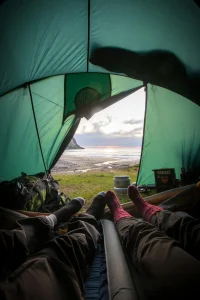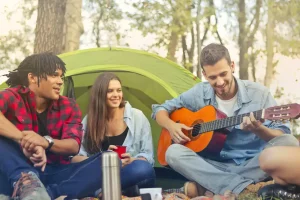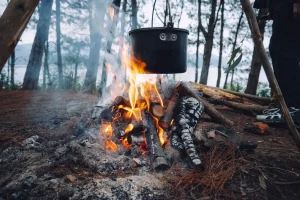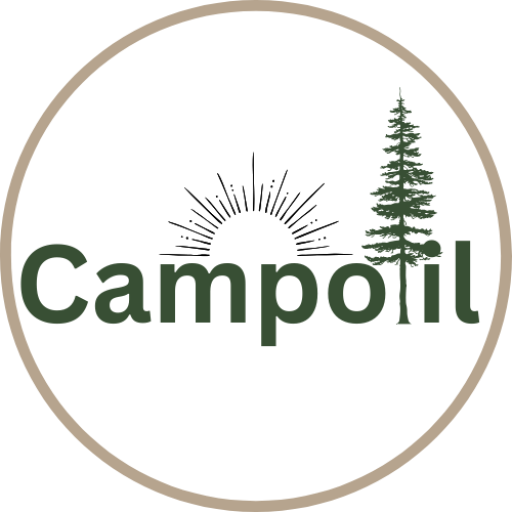Introduction: The Joy of the Outdoors Without Breaking the Bank
I still remember my first budget camping trip. A few friends and I packed up a borrowed tent, used some old sleeping bags, and headed to Great Smoky Mountains National Park for the weekend. We cooked simple meals over a campfire, hiked scenic trails, and gazed at the stars—all without spending much money. That trip taught me that camping doesn’t have to be expensive to be amazing.
“Camping on a budget” is all about smart planning, creativity, and making the most of what you have. Whether you’re using secondhand gear, choosing free campsites, or cooking affordable meals, there are plenty of ways to enjoy the great outdoors without spending a fortune.
In this article, we’ll explore practical tips and strategies to save money on camping gear, campsite fees, food, and travel. With the rising interest in budget-friendly outdoor recreation, more people are discovering that adventure is priceless—but it doesn’t have to be costly. In fact, a recent report found that camping participation in the U.S. has grown by over 30% in the past decade, with many campers looking for low-cost ways to explore nature.
Personal Tip: Camping on a budget doesn’t mean sacrificing fun, comfort, or safety—it just means being resourceful. Ready to hit the trail without breaking the bank? Let’s dive in!

Gear Acquisition: Smart Shopping and Resourcefulness
Camping gear can be expensive, but you don’t have to buy everything brand new. With a little creativity, you can find high-quality gear at a fraction of the price or even make some yourself. Here’s how to build your camping setup without breaking the bank.
Buying Used Gear: Quality Without the Cost
There’s a lot of great camping gear out there that has only been used a few times. Buying secondhand can save you 50% or more on essentials like tents, sleeping bags, and backpacks.
✅ Where to Find Used Gear:
- Online marketplaces like Facebook Marketplace, Craigslist, and eBay
- Thrift stores and outdoor gear swaps
- REI Garage Sales (for returned and discounted items)
How to Inspect Used Gear:
- Tents: Check for rips, broken zippers, and missing stakes.
- Sleeping bags: Make sure the insulation is still fluffy and there are no bad smells.
- Backpacks: Inspect straps, buckles, and seams for wear and tear.
️ Pros & Cons of Buying Used:
✔️ Saves money
✔️ Keeps gear out of landfills
✔️ Often high-quality brands at lower prices
❌ Limited selection
❌ No manufacturer’s warranty
Renting Gear: When Borrowing Makes More Sense
If you only camp a few times a year, renting might be a cheaper and easier option than buying. It also lets you test different gear before committing.
️ Where to Rent Camping Gear:
- Local outfitters and hiking stores
- National parks (some offer rentals for bear canisters, tents, and more)
- Online rental services like Arrive Outdoors and Outdoors Geek
Pros & Cons of Renting:
✔️ Saves money on rarely used items
✔️ No need for long-term storage
✔️ Try out expensive gear before buying
❌ Costs add up over multiple trips
❌ Limited availability in some areas
DIY Gear and Repurposing: Get Creative!
Some camping gear can be easily made or repurposed from things you already own. This not only saves money but also reduces waste.
Simple DIY Camping Gear Ideas:
- Tarp shelter – A simple alternative to an expensive tent
- Homemade fire starter – Use dryer lint and wax to make lightweight fire starters
- DIY camp stove – A small aluminum can and rubbing alcohol can become a makeshift stove
♻️ Repurposing Household Items for Camping:
- Old yoga mats → Sleeping pads
- Pill bottles → Waterproof match containers
- Plastic peanut butter jars → Food storage
Did You Know? Around 11 million tons of textiles and outdoor gear end up in landfills each year. By buying used, renting, or repurposing gear, you help reduce waste and save money!

Strategic Sales and Discounts: Timing is Everything
If you prefer new gear, the best way to save money is to buy at the right time and use discounts.
How to Get the Best Deals on Camping Gear:
- Shop off-season – Buy winter gear in summer and vice versa.
- Look for clearance sales – Stores like REI, Backcountry, and Cabela’s often have big markdowns.
- Use coupons and promo codes – Websites like Honey and RetailMeNot can help.
- Join outdoor gear loyalty programs – Stores like REI Co-op offer discounts, dividends, and exclusive deals.
Trip Planning: Maximizing Value and Minimizing Costs
Camping is one of the most affordable ways to travel, but without proper planning, costs can add up fast. From choosing the right destination to cutting food and transportation expenses, here’s how to make your camping trip both budget-friendly and unforgettable.
Choosing Budget-Friendly Destinations
Some campsites charge $20–$50 per night, but you don’t have to pay a fortune to camp. Here are a few low-cost or free options:
Free or Low-Cost Camping Options:
- National forests & BLM land – Many offer free dispersed camping with no reservation fees.
- State parks – Cheaper than national parks, often with great amenities.
- Local camping spots – Stay close to home to reduce travel costs.
️ Camping in the Off-Season:
- Avoid peak summer months – Campground fees drop in spring and fall.
- Fewer crowds – Enjoy a peaceful experience with more campsite availability.
Meal Planning and Food Costs
Camp cooking doesn’t have to be expensive. With a little planning, you can save money and eat well!
Budget-Friendly Camping Meals:
- Oatmeal with nuts & dried fruit – Cheap, filling, and easy to pack.
- Foil pack meals – Throw chopped veggies, potatoes, and sausage in foil and cook over the fire.
- Rice and beans – A camping staple that’s nutritious, cheap, and easy to make.
Smart Food Packing Tips:
- Buy in bulk – Save money by purchasing rice, pasta, and canned goods in larger quantities.
- Meal prep at home – Chop veggies, marinate meat, and pre-make snacks.
- Stick to non-perishable foods – They last longer and reduce food waste.
Personal Story: One of my favorite cheap camping meals is campfire quesadillas. All you need are tortillas, cheese, beans, and a skillet. Cook over a fire, and you have a warm, delicious meal for just a few bucks!
Transportation Costs
Gas prices can make a camping trip more expensive than expected. Save money by choosing the right travel strategy.
How to Cut Transportation Costs:
- Carpool with friends – Split gas costs and make the drive more fun.
- Pick campsites closer to home – A hidden gem an hour away can be just as amazing as a faraway destination.
- Practice fuel-efficient driving – Maintain a steady speed, reduce idling, and pack light to save gas.
✈️ Public Transportation Option: If you’re near a national park or big campground, check if shuttles or buses are available. Many places offer free or cheap rides!
Free or Low-Cost Activities
Camping doesn’t have to include expensive tours or rentals. There are plenty of free ways to enjoy the outdoors!
️ Best Free Camping Activities:
- Hiking – Explore scenic trails at places like Great Smoky Mountains National Park (no entrance fee!).
- Swimming – Many state parks and campgrounds have free lakes and rivers to swim in.
- Stargazing – No special equipment needed—just a clear night sky.
- Wildlife watching – Bring binoculars and keep an eye out for deer, birds, or even bears (from a safe distance!).
Finding Free Local Events: Check campground bulletin boards or visitor center websites for free ranger programs, nature talks, and guided hikes.
Avoiding Tourist Traps
Big-name parks and attractions can be expensive, but you can find incredible places without the high costs.
How to Avoid Overpriced Locations:
- Skip crowded national parks and explore state parks or national forests instead.
- Look for free viewpoints instead of paying for observation decks.
Hidden Gems Over Touristy Spots:
Instead of Yosemite National Park, try Lassen Volcanic National Park—same stunning landscapes but cheaper fees and fewer people.
Budget-Friendly Camping Techniques: Practical Tips and Strategies
Camping doesn’t have to be expensive. With the right approach, you can enjoy the outdoors without spending a fortune. From free campsites to splitting costs with friends, here are some of the best budget-friendly camping strategies to help you save money while still having an amazing adventure.
Dispersed Camping and Backcountry Options
One of the best ways to camp for free is dispersed camping, which means setting up camp outside designated campgrounds. Many national forests, Bureau of Land Management (BLM) lands, and wilderness areas allow free camping with no fees.
Why Choose Dispersed Camping?
- It’s free – No need to pay for campsites.
- More solitude – No crowded campgrounds or noisy neighbors.
- Beautiful locations – Stay near lakes, rivers, and mountains for free.
Important Regulations & Permits
- Check local rules – Some areas require free permits for dispersed camping.
- Follow Leave No Trace principles – Pack out all trash and respect nature.
- Stay within limits – Many areas allow camping for up to 14 days at a time.
️ Backcountry Camping Skills You Need
- Map and compass navigation – Many dispersed sites have no cell service.
- Water purification – Carry a water filter or boiling kit.
- Bear safety – Store food in bear-proof containers in areas with wildlife.
Example Location: Pisgah National Forest (North Carolina) offers miles of free dispersed camping spots near waterfalls and hiking trails.

Group Camping and Shared Resources
Camping with friends or family is a great way to cut costs while making the trip more fun!
How to Save Money with Group Camping
- Split campsite fees – Many campgrounds charge per site, not per person.
- Share gear – No need for everyone to bring their own tent, stove, or lantern.
- Group meals – Cooking large portions is cheaper than making individual meals.
Planning Fun Group Activities
- Campfire storytelling – Bring a book or share personal camping stories.
- Hiking together – Many national parks have trails suited for all skill levels.
- DIY scavenger hunt – Create a nature hunt for kids and adults.
️ Pro Tip: Plan one big meal everyone contributes to, like a chili pot or grilled feast. It’s cheaper, easier, and brings everyone together!
Off-Season Camping Advantages
Camping during the off-season (fall, winter, and early spring) has major benefits.
Why Off-Season Camping is Great:
- Lower campsite fees – Some campgrounds reduce or eliminate fees in the off-season.
- Fewer crowds – Enjoy peaceful, quiet campsites without peak-season tourists.
- Unique scenery – See fall colors, snowy landscapes, or spring wildflowers.
How to Stay Warm While Camping in Cold Weather
- Bring insulated sleeping pads – They keep cold air from the ground away.
- Layer clothing – Wear thermal base layers, fleece, and a windproof jacket.
- Use hot water bottles – Fill a metal water bottle with hot water and put it in your sleeping bag for warmth.
Example Location: Shenandoah National Park (Virginia) offers stunning fall foliage, cheaper off-season camping rates, and quieter trails.
Volunteer Opportunities: Camping for Free
Did you know you can camp for free by volunteering? Many organizations offer free campsites in exchange for help with trail maintenance, campsite cleanup, or conservation projects.
Ways to Camp for Free by Volunteering:
- National Park Service – Join volunteer programs at parks like Yellowstone or Grand Canyon.
- Trail maintenance groups – Many organizations, like the Appalachian Trail Conservancy, offer free camping to volunteers.
- State park cleanup events – Help with trash pickup, trail restoration, or wildlife monitoring.
️ How to Find Volunteer Opportunities:
- Check national and state park websites for volunteer listings.
- Join local hiking and camping Facebook groups.
- Visit Volunteer.gov to find opportunities across the U.S.
️ Pro Tip: Some programs provide free meals or gear discounts for volunteers!
Gear Maintenance and Longevity: Extending the Life of Your Equipment
Camping gear is an investment, and taking care of it properly can save you money in the long run. Instead of replacing expensive gear, a little maintenance can keep your equipment in top shape for years. Here’s how to make your camping gear last longer and avoid unnecessary costs.
Proper Cleaning and Storage
One of the biggest mistakes campers make is not cleaning and storing their gear properly. Dirty or damp gear can lead to mold, mildew, and damage.
✅ Best Practices for Cleaning & Storing Gear:
- Tents – Shake out dirt and debris, then wipe down with mild soap and water. Let it dry completely before storing.
- Sleeping Bags – Wash according to the manufacturer’s instructions and store loosely in a breathable sack, not compressed.
- Cooking Gear – Scrub pots, pans, and stoves after each trip. Store them in a dry, organized bin to prevent rust.
️ Pro Tip: Store your gear in a cool, dry place like a closet or garage shelf, not in a damp basement or attic.
Basic Repairs and Maintenance
Instead of tossing out worn gear, learn some simple repair tricks! You’d be surprised how easy it is to patch up small rips or fix broken zippers.
Essential Gear Repair Tips:
- Patching Tents & Sleeping Bags – Use gear patches or waterproof tape for small tears.
- Maintaining Stoves & Lanterns – Clean burners, replace old fuel canisters, and store them properly.
- Sharpening Knives & Tools – A dull knife is dangerous—keep blades sharp with a simple pocket sharpener.
Real-World Example: Many campers in Yosemite National Park rely on repairing gear instead of replacing it since backcountry stores can be expensive!
Upcycling and Repurposing Old Gear
Even when gear reaches the end of its life, it can still be useful. Instead of throwing things away, try repurposing them into something new!
♻️ Creative Ways to Upcycle Old Gear:
- Turn an old tent into a tarp or a waterproof ground cloth.
- Use worn-out sleeping bags as extra blankets for cold nights.
- Transform an old backpack into a gear organizer for car camping.
Personal Take: There’s something so satisfying about giving old gear a new purpose. Not only does it save money, but it’s also better for the environment!
Regular Inspections: Catching Problems Early
Before each trip, take a few minutes to inspect your gear. A small rip in your tent or a broken strap on your backpack is much easier to fix at home than in the wilderness.
Pre-Trip Gear Inspection Checklist:
✅ Check tent poles, seams, and zippers for damage.
✅ Look for worn-out straps or holes in backpacks.
✅ Test your stove and lanterns to make sure they work.
✅ Replace batteries in headlamps and flashlights.
️ Pro Tip: Keep a small gear repair kit in your backpack. A few patches, duct tape, and a multi-tool can save the day!
Food and Water Strategies: Eating Well on a Budget
Camping on a budget doesn’t mean you have to settle for bland, expensive, or unhealthy meals. With a little planning, you can enjoy delicious and nutritious food without spending a fortune. Here’s how to eat well while keeping costs low on your next camping adventure.
A. Dehydrated and Homemade Meals
Buying pre-packaged dehydrated meals can get expensive, but making your own is a budget-friendly alternative.
✅ How to Make Your Own Dehydrated Meals:
- Choose simple ingredients like rice, pasta, beans, and dried veggies.
- Cook meals ahead of time, then dehydrate them using an oven (on low heat) or a dehydrator.
- Store them in airtight bags or containers for easy packing.
- Rehydrate with boiling water at the campsite for a quick meal.
Example: A homemade dehydrated chili with beans, tomatoes, and spices is a hearty and affordable meal that only needs hot water to bring it back to life!
B. Foraging and Wild Edibles (With Caution!)
Foraging can be a fun way to supplement your meals, but it requires knowledge and care.
Tips for Safe Foraging:
- Learn to identify edible plants, berries, and mushrooms. Dandelions, wild onions, and cattails are common wild edibles in the U.S.
- Follow local rules—some national parks prohibit foraging.
- Always double-check identification using a foraging guidebook or app.
Warning: Never eat a plant unless you’re 100% sure it’s safe! Some wild plants are toxic.
C. Water Purification and Filtration
Carrying all your water can be heavy and expensive. Instead, use natural water sources and purify them properly.
Affordable Water Purification Methods:
- Water Filters: Lightweight and reusable, perfect for filtering river or lake water.
- Purification Tablets: Cheap, small, and effective against bacteria.
- Boiling: A simple, no-cost method—just heat water for at least 1 minute.
️ Example: If you’re camping in Yosemite National Park, refill your bottles from streams, but always purify the water to avoid illness.

D. Cooking Over Campfires
Why bring a stove when nature provides free heat? Campfire cooking is an excellent way to save money.
Campfire Cooking Tips:
- Use available firewood where allowed (or bring some from home).
- Stick to easy, one-pot meals like foil-wrapped potatoes, soups, or grilled veggies.
- Follow fire safety rules—keep water nearby and never leave a fire unattended.
Personal Experience: I once made the best grilled cheese sandwich over a fire at Great Smoky Mountains National Park. The smoky flavor made it unforgettable!
Eating well while camping on a budget is totally possible with the right strategies. Whether you make dehydrated meals, try foraging, filter your own water, or cook over a campfire, you can enjoy delicious meals without overspending.
What’s your favorite budget-friendly camping meal? Share your tips in the comments!
Transportation and Travel Hacks: Getting There for Less
Getting to your camping destination can be one of the biggest expenses, but with the right strategies, you can cut costs without sacrificing adventure. Here’s how to save money on transportation while still enjoying the great outdoors.
A. Road Trip Strategies
Driving to your campsite? Use these fuel-saving techniques to make your gas last longer:
Fuel-Efficient Driving Tips:
- Drive at a steady speed and avoid sudden braking.
- Use cruise control on highways to improve gas mileage.
- Keep tires properly inflated to reduce fuel consumption.
Utilize Fuel-Saving Apps:
- GasBuddy and Waze help find the cheapest gas stations on your route.
- Some grocery stores offer fuel discounts—check if your local store has a rewards program.
Pack Smartly:
- A heavy car burns more fuel, so only bring camping gear you actually need.
- Secure items properly to reduce wind resistance and improve gas mileage.
B. Public Transportation and Shuttle Services
If you don’t have a car (or just want to save on gas), public transportation can be a great budget-friendly option.
Taking Buses and Trains to Campsites:
- Many national parks have train or bus routes nearby. For example, Yosemite National Park offers shuttle services to popular campgrounds.
- Some states, like Colorado, provide bus routes that connect major cities to outdoor destinations.
Shuttle Services for Remote Locations:
- Some parks offer free or low-cost shuttles, like Zion National Park’s shuttle system.
- Many outdoor adventure companies provide transportation to hiking trails and campgrounds for a small fee.
C. Local Camping and Day Trips
One of the best ways to save money on camping trips is to stay close to home.
️ Benefits of Local Camping:
- No need to spend money on gas, flights, or rentals.
- More time enjoying nature, less time driving.
- Many local parks and state forests offer free or low-cost camping spots.
Cost-Saving Statistic:
According to the Outdoor Industry Association, the average camping trip costs around $76 per day per person, including transportation, food, and gear. Choosing a nearby destination or using budget-friendly camping techniques can cut that cost in half!
With a little planning, you can enjoy affordable camping trips without breaking the bank. Whether you use fuel-saving tips, take public transportation, or explore local campsites, you can spend more time in nature and less money on travel.
What’s your favorite way to save on transportation for camping trips? Share your tips below!
Conclusion: Embracing Affordable Outdoor Adventures
Camping doesn’t have to be expensive. By using budget-friendly camping strategies like buying used gear, choosing free or low-cost campsites, meal prepping, and saving on transportation, you can enjoy the outdoors without spending a fortune.
Nature is for everyone, and no one should feel like they can’t experience the beauty of national parks, hiking trails, and scenic campgrounds just because of cost. With a little creativity—like repurposing gear, carpooling, or volunteering at campsites—you can make every trip more affordable and even more rewarding.
Final Thought: Camping isn’t about fancy gear or expensive destinations. It’s about fresh air, crackling campfires, and the simple joy of being outside. Whether you’re sleeping under the stars at Yosemite National Park or pitching a tent in a quiet state forest, the best memories come from the adventure itself—not how much you spend.
Now, I want to hear from you! What are your favorite budget-friendly camping hacks? Share your tips in the comments and help others save on their next outdoor adventure!
